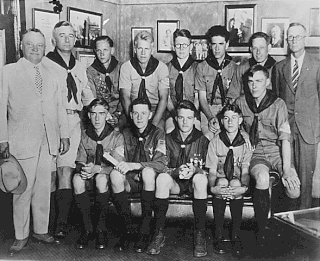
Scouting in Michigan has a long history, from the 1910s to the present day, serving thousands of youth in programs that suit the environment in which they live.

Scouting in North Carolina has a long history, from the 1910s to the present day, serving thousands of youth in programs that suit the environment in which they live.

Ocracoke is a census-designated place (CDP) and unincorporated town located at the southern end of Ocracoke Island, located entirely within Hyde County, North Carolina, United States. The population was 948 as of the 2010 census. In the 2020 census, the population had dropped to 797 people.

Cape Lookout National Seashore preserves a 56-mile (90-km) long section of the Southern Outer Banks, or Crystal Coast, of North Carolina, USA, running from Ocracoke Inlet on the northeast to Beaufort Inlet on the southwest. Three undeveloped barrier islands make up the seashore - North and South Core Banks and Shackleford Banks. The seashore includes two historic villages on Core Banks, Shackleford's wild horses, and the Cape Lookout Lighthouse, which has a black-and-white diamond pattern. A visitor center for the seashore is located on Harkers Island.

Hurricane Alex was one of the northernmost major hurricanes on record, and whose formation marked the fifth-latest start to a season since 1954. The first named storm, the first hurricane, and the first major hurricane of the 2004 Atlantic hurricane season, Alex developed from the interaction between an upper-level low and a weak surface trough on July 31 to the east of Jacksonville, Florida. It moved northeastward, and strengthened to attain winds of 100 mph (160 km/h) before passing within 10 miles (16 km) of the Outer Banks coast. Alex strengthened further and reached a peak of 120 mph (190 km/h) winds while off the coast of New England, one of only six hurricanes to reach Category 3 status north of 38° N. Alex caused a scare of a hurricane-force direct hit in the Outer Banks of North Carolina, which had been devastated by Hurricane Isabel less than a year earlier.

Corolla is an unincorporated community located in Poplar Branch township, Currituck County, North Carolina, United States, along the northern Outer Banks. It has a permanent population of approximately 500 people; during the summer vacation season, the population surges into the thousands. Corolla is home to the Currituck Beach Lighthouse, one of the seven North Carolina coastal lighthouses.

Colonial Spanish horse is a term for a group of horse breed and feral populations descended from the original Iberian horse stock brought from Spain to the Americas. The ancestral type from which these horses descend was a product of the horse populations that blended between the Iberian horse and the North African Barb. The term encompasses many strains or breeds now found primarily in North America. The status of the Colonial Spanish horse is considered threatened overall with seven individual strains specifically identified. The horses are registered by several entities.

Herbert Covington Bonner was a Democratic U.S. Congressman from North Carolina between 1940 and 1965.
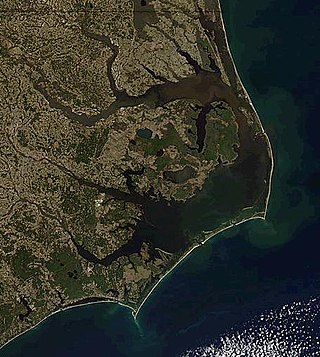
The Outer Banks are a 200 mi (320 km) string of barrier islands and spits off the coast of North Carolina and southeastern Virginia, on the east coast of the United States. They line most of the North Carolina coastline, separating Currituck Sound, Albemarle Sound, and Pamlico Sound from the Atlantic Ocean. A major tourist destination, the Outer Banks are known for their wide expanse of open beachfront and the Cape Hatteras National Seashore. The seashore and surrounding ecosystem are important biodiversity zones, including beach grasses and shrubland that help maintain the form of the land.
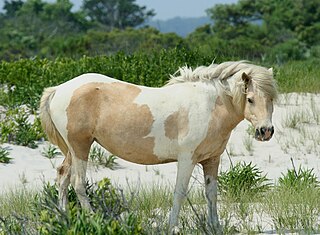
The Chincoteague pony, also known as the Assateague horse, is a breed of horse that developed, and now lives, within a semi-feral or feral population on Assateague Island in the US states of Virginia and Maryland. The Chincoteague pony is one of the many breeds of feral horses in the United States. The breed was made famous by the Misty of Chincoteague novels, written by pony book author Marguerite Henry, and first published in 1947, and the pony Misty of Chincoteague.
Shackleford Banks is a barrier island system on the coast of Carteret County, North Carolina. It contains a herd of feral horses, scallop, crabs and various sea animals, including summer nesting by loggerhead turtles. It is a tourist and beach camping site.
The Florida Cracker Horse is a critically endangered horse breed from the state of Florida in the United States. It is genetically and physically similar to many other Spanish-style horses, especially those from the Spanish Colonial horse group, including the Banker horse of North Carolina, and the Carolina Marsh Tacky of South Carolina.

North Carolina Highway 12 (NC 12) is a 148.0-mile-long (238.2 km) primary state highway in the U.S. state of North Carolina, linking the peninsulas and islands of the northern Outer Banks. Most sections of NC 12 are two lanes wide, and there are also two North Carolina Ferry System routes which maintain continuity of the route as it traverses the Outer Banks region. NC 12 is part of the Outer Banks Scenic Byway, a National Scenic Byway. The first NC 12 appeared on the 1924 North Carolina Official Map and at its greatest length ran from NC 30 in Pollocksville to NC 48 near Murfreesboro. Over time it was replaced by both U.S. Route 258 (US 258) and NC 58 and ceased to exist in 1958. The current NC 12 first appeared on the 1964 state highway map running from US 158 in Nags Head to Ocracoke. In 1976 NC 12 was extended to US 70 on the mainland and in 1987 was extended north to Corolla.

A feral horse is a free-roaming horse of domesticated stock. As such, a feral horse is not a wild animal in the sense of an animal without domesticated ancestors. However, some populations of feral horses are managed as wildlife, and these horses often are popularly called "wild" horses. Feral horses are descended from domestic horses that strayed, escaped, or were deliberately released into the wild and remained to survive and reproduce there. Away from humans, over time, these animals' patterns of behavior revert to behavior more closely resembling that of wild horses. Some horses that live in a feral state but may be occasionally handled or managed by humans, particularly if privately owned, are referred to as "semi-feral".
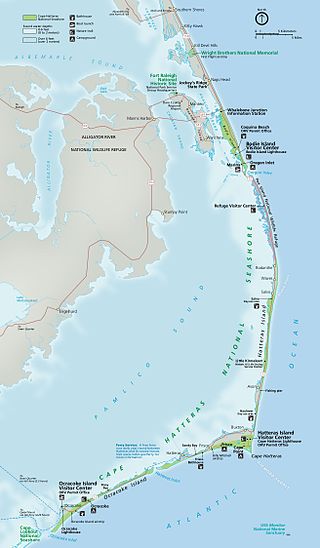
Hatteras Inlet is an estuary in North Carolina, located along the Outer Banks, separating Hatteras Island and Ocracoke Island. It connects the Atlantic Ocean to the Pamlico Sound. Hatteras Inlet is located entirely within Hyde County.

Ocracoke Inlet is an estuary located in the Outer Banks, North Carolina, United States that separates Ocracoke Island and Portsmouth Island. It connects the Atlantic Ocean to the Pamlico Sound. It is the southern terminus of the Cape Hatteras National Seashore, and the northern terminus of the Cape Lookout National Seashore. The inlet is approximately two miles across, although it changes daily.
The Banker horse is a breed of semi-feral or feral horse living on barrier islands in North Carolina's Outer Banks. It is small, hardy, and has a docile temperament, and is genetically related to the Carolina Marsh Tacky of South Carolina and Florida Cracker Horse breeds through their shared Colonial Spanish horse and Iberian horse descent. The current population of wild Banker horses is estimated to be about 400.
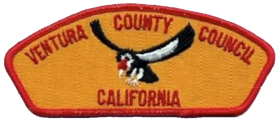
Ventura County Council of the Boy Scouts of America was officially chartered as Council 57 on June 23, 1921, after a series of meetings that followed a proposal put forward at a County Chamber of Commerce meeting on March 28, 1921, in the Masonic Hall. Mr. C. H. Whipple, then of Moorpark and later Oxnard, became the president; and Col. J.L. Howland became commissioner. Harvey R. Cheesman, an assistant scout executive in the Los Angeles Council, became the first Scout Executive, assuming his duties on July 11.

Mount Diablo Silverado Council was a local council of the Scouts BSA and was one of six councils that serves the San Francisco Bay area in California. The council's office was located in Pleasant Hill, California. It served chartered organizations and BSA units in Contra Costa County, Lake County, Napa County, Solano County, and the cities of Albany and Berkeley in northern Alameda County. The council is located in BSA Western Region Area III. It merged with Alameda Council #021 and San Francisco Bay Area Council #028 in June 2020 to form the Golden Gate Area Council #023.

The Corolla Wild Horses Protection Act is a bill that was introduced into the 113th United States Congress, where it passed the United States House of Representatives. The bill would affect wild horses living in North Carolina.


















